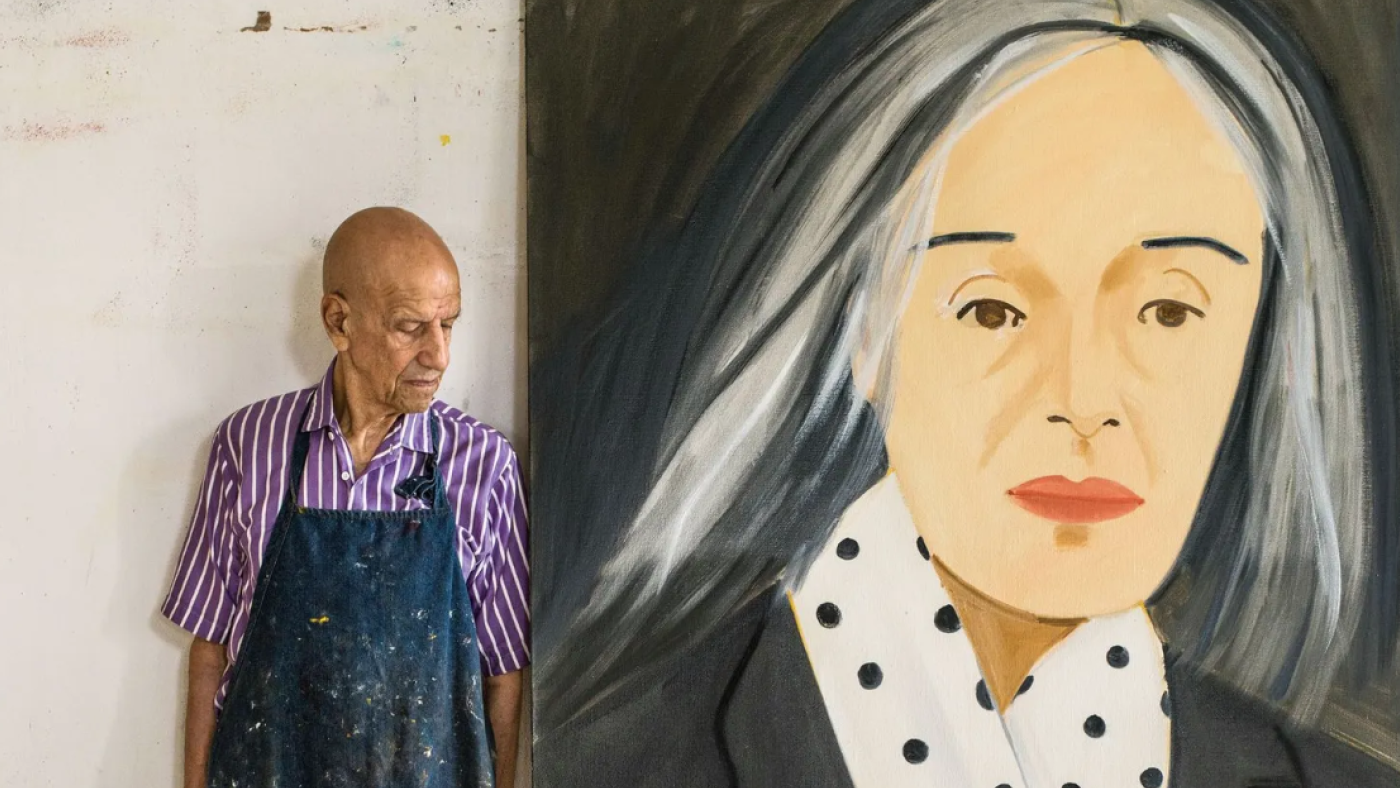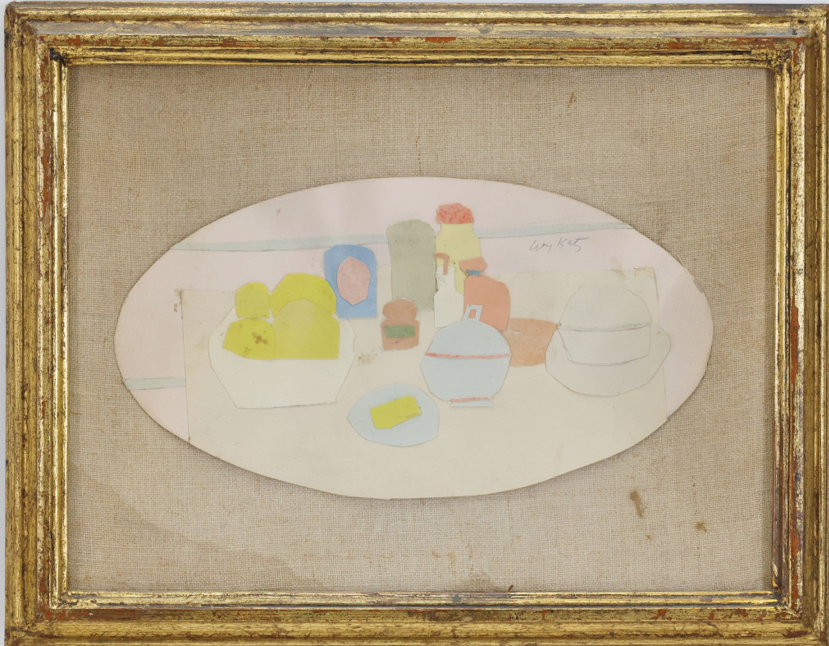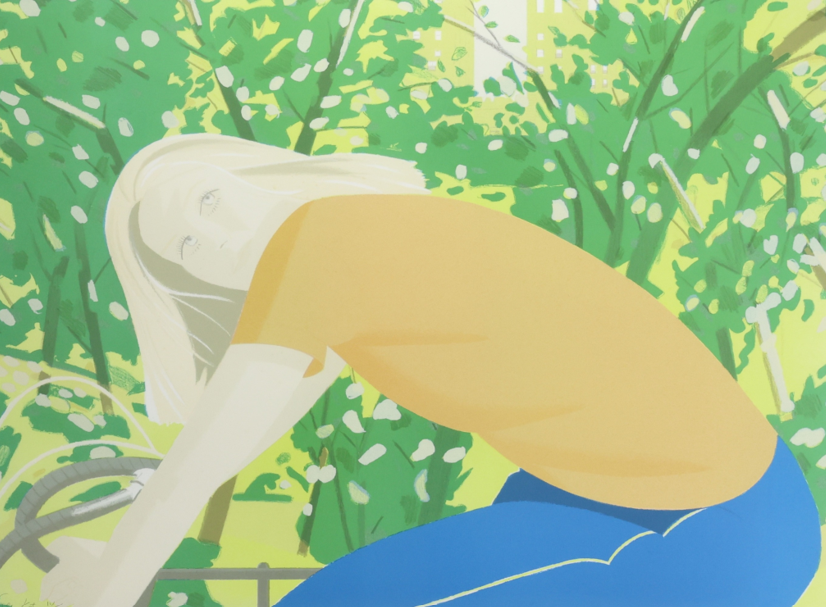Alex Katz: Bridging Realism and Abstraction in the Modern Era

Alex Katz: Bridging Realism and Abstraction in the Modern Era
Written by: Christian Answini | Senior Fine Art Specialist
Alex Katz (born July 24, 1927) is one of the most recognizable voices in post war American art. Raised in Brooklyn and later Queens, Katz studied at the Cooper Union School of Art and the Skowhegan School of Painting and Sculpture in Maine. At Skowhegan he practiced painting en plein air and learned to work quickly, an experience he said gave him “a reason to devote my life to painting.” In the early 1950s he began exhibiting his work and soon developed a style that stood apart from the prevailing Abstract Expressionism. He destroyed much of his early output, but in Maine he produced small collages of still lifes, landscapes and figures, a foundation for later experiments.
A distinctive type of realism
Katz’s paintings are almost evenly divided between portraiture and landscape. Since the 1960s he has painted views of New York and the coast of Maine, as well as portraits of family, writers, dancers and New York socialites. His paintings are defined by flat planes of color, simplified forms, an economy of line and a cool emotional detachment. In the early 1960s, influenced by films and billboard advertising, he began painting large scale works with dramatically cropped faces and figures. Katz developed a technique of painting on cut panels of wood or aluminum, creating painted silhouettes called cutouts; these works occupy space like sculpture yet retain the crispness of his canvases.
Art historian Robert Storr described Katz’s achievement as “a new and distinctive type of realism in American art which combines aspects of both abstraction and representation.” Katz came of age between Abstract Expressionism and Pop Art, and his early work drew inspiration from mid century culture including television, film and advertising. Over more than five decades he has become a preeminent painter of modern life whose portraits and lyrical landscapes bear flattened surfaces and a consistent economy of line. He applies characteristically wide brushstrokes and large swaths of color to create refined, objective compositions; these hallmarks would influence later Pop artists and are seen as precursors to the movement.
Katz’s career is remarkable for its breadth. Since the 1950s he has been the subject of more than 200 solo exhibitions and nearly 500 group shows worldwide, including recent retrospectives at the Solomon R. Guggenheim Museum (2022 23) and Colby College. His work is held in major collections such as the Art Institute of Chicago, the Smithsonian’s Hirshhorn Museum and Sculpture Garden, the Metropolitan Museum of Art and the Museum of Modern Art, New York. Despite his popularity, Katz remains a maverick. He paints portraits of fashion models and poets as easily as he designs sets for choreographer Paul Taylor. His group portrait One Flight Up (1968) portrays more than thirty members of New York’s intellectual circle and highlights his ability to capture social scenes with pared down forms.
Mid Century Modern aesthetics
Katz’s minimal modeling, flattened space and saturated palette resonate with mid century modern design. Mid century furniture and interiors favored clean lines and organic forms; Katz’s paintings complement that aesthetic with their bold blocks of color and stripped down compositions. His work shares affinities with the graphic clarity of advertising and fashion illustration, yet he uses these devices to distill moments from everyday life. The use of negative space and the reduction of detail create images that feel both contemporary and timeless.
A key aspect of Katz’s appeal is his ability to balance realism with abstraction. Faces and figures are recognizable, yet they are reduced to essential contours; landscapes are rendered as broad color fields rather than descriptive detail. This synthesis makes his work versatile in modern interiors, where it can bridge decorative and fine art considerations. Collectors of mid century modern design appreciate how Katz’s canvases and prints echo the era’s streamlined aesthetics while introducing a human presence.
Works at Alderfer Auction
Alderfer Auction’s Mid Century Modern Auction on September 3 presents two distinctive examples of Katz’s work. Both pieces reflect his modernist vision and would make strong additions to a mid century or contemporary collection.

This intimate collage demonstrates Katz’s early interest in cut paper compositions. Composed of layered paper cutouts, the oval arrangement depicts stylized kitchen forms — bowls, bottles and fruit — rendered in pastel yellows, blues and oranges. The simplicity of each shape recalls Katz’s still life collages made during the 1950s when he refined his eye by making small studies in Maine. The juxtaposition of soft colors and flat forms creates a rhythmic balance between positive and negative space. Mounted within a linen mat and gilt frame, the collage has the handcrafted charm of mid century studio art while foreshadowing the artist’s mature vocabulary.

The color lithograph Bicycle Rider captures a young woman cycling through a park, rendered in the clear light and flat planes typical of Katz’s prints. The rider’s orange shirt and cobalt pants contrast against a background of verdant greens, echoing the bold complementary palettes of mid century interiors. Simplified shapes define the figure and bicycle; details are reduced to essential contours, and shadows are eliminated. Katz crops the scene tightly, focusing on the curve of the rider’s back turning an everyday moment into a stylized design. Numbered IX/XXXX and signed in pencil, the print measures 22” by 30”. As a lithograph produced in an edition, it offers collectors an accessible entry point into Katz’s oeuvre.
Why these works matter
Both works offered by Alderfer Auction exemplify Katz’s ability to fuse modernist design with humanist observation. The Untitled collage underscores his exploration of color and shape through humble materials, a practice that helped him develop the disciplined simplicity seen in his later paintings. Its pastel palette and domestic subject would complement a mid century dining room or kitchen, resonating with the era’s interest in everyday objects rendered with elegance.
Bicycle Rider demonstrates Katz’s mature mastery of flat planes and bold colors. The print’s crisp contours and subtle cropping place it firmly within the mid century aesthetic; yet the motion of the cyclist and the dappled greenery convey a sense of presentness that keeps the image fresh. Its horizontal format and vibrant palette make it an ideal focal point above a sofa or console in a modern or contemporary interior.
Alex Katz remains an important figure in American art because he distilled the dynamism of mid century culture into a visual language that bridges realism and abstraction. His ability to capture fleeting moments with clarity and restraint ensures that his work continues to resonate with new generations of collectors and design enthusiasts. The pieces at Alderfer Auction offer an opportunity to own examples of Katz’s vision and to enrich a space with art that is both timeless and unmistakably modern.










